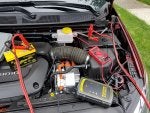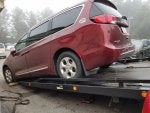The van was standing unused for about 5 days. This morning I found it completely dead. Unlocked it with a key, opened the sliding door and went to check the battery in the rear. Soon realized that the accessible battery terminal is ground, and remembered that there is a post in the fuse block directly connected to the positive terminal of the battery. Measured the voltage- it was 3.5 Volts.
Called the dealer and ask if I could bring them the bad battery and get a new one under warranty. The answer was no. They were happy to sell me the battery for $220, but I had to call for a tow truck to get it fixed under warranty.
Decided to charge to see if I could get the van to start and get it to the dealer without the tow. With the charger connected the voltage rose to 6 Volts. The horn relay started to click every second and the turn signals flashed albeit very weakly- the van was trying to sound alarm. I pulled the horn fuse (71) to reduce the load on electrical system and was able to stop the alarm from the remote. Left the van to charge.
Two hours later the voltage was still less than 7V. I think it means that at least one cell in the battery failed completely. I needed to get something from the van, so I opened the sliding door, got my things, went to shut the door and could not do it! The rear latch wouldn't lock. I didn't take a picture, so I'll use a picture to show what happened.
![Image]()
The latch was in the position like on the right picture in the first row and the pin couldn't go in! I tried to pull inside and outside handles, rotate the latch with a screwdriver, all to no avail. Like most of the van, that latch is electrically driven, and with 6 volts on tap it wasn't moving. By this time the dealer was closed. The van was parked outside and the sky looked gloomy. MacGyver time.
I had a spare UPS battery and decided to try to power the van with it. I climbed inside and disconnected the 12V battery, than connected the UPS battery to supplement the charger. It did the trick. The van turned on and I could operate the door with the button!
Reconnected the 12V battery and left the van charging for a few more hours. When I came back in the evening, the voltage was up to 11.8V and the van showed signs of life. Tried to start it, but got the flashing MIL and the "Service charging system" message. The van wouldn't move. An OBDII scanner read a bunch of codes. They were either "no communication" or "low voltage" from various systems- from Battery Control to ABS. I hope it means that the van expects more that 11.8V and the codes will go away with a new battery.
This is where I stand now. Not completely stranded, but without the most comfortable vehicle for weekend travel. I'm reluctant to blame Chrysler for a generic component failure, but still have to question their choice of the supplier. Another concern is whether the codes will clear once the battery is replaced. I'm not comfortable with a vehicle which needs a dealer level diagnostics and service just to change a battery- a simple work many people do by themselves.
Called the dealer and ask if I could bring them the bad battery and get a new one under warranty. The answer was no. They were happy to sell me the battery for $220, but I had to call for a tow truck to get it fixed under warranty.
Decided to charge to see if I could get the van to start and get it to the dealer without the tow. With the charger connected the voltage rose to 6 Volts. The horn relay started to click every second and the turn signals flashed albeit very weakly- the van was trying to sound alarm. I pulled the horn fuse (71) to reduce the load on electrical system and was able to stop the alarm from the remote. Left the van to charge.
Two hours later the voltage was still less than 7V. I think it means that at least one cell in the battery failed completely. I needed to get something from the van, so I opened the sliding door, got my things, went to shut the door and could not do it! The rear latch wouldn't lock. I didn't take a picture, so I'll use a picture to show what happened.

The latch was in the position like on the right picture in the first row and the pin couldn't go in! I tried to pull inside and outside handles, rotate the latch with a screwdriver, all to no avail. Like most of the van, that latch is electrically driven, and with 6 volts on tap it wasn't moving. By this time the dealer was closed. The van was parked outside and the sky looked gloomy. MacGyver time.
I had a spare UPS battery and decided to try to power the van with it. I climbed inside and disconnected the 12V battery, than connected the UPS battery to supplement the charger. It did the trick. The van turned on and I could operate the door with the button!
Reconnected the 12V battery and left the van charging for a few more hours. When I came back in the evening, the voltage was up to 11.8V and the van showed signs of life. Tried to start it, but got the flashing MIL and the "Service charging system" message. The van wouldn't move. An OBDII scanner read a bunch of codes. They were either "no communication" or "low voltage" from various systems- from Battery Control to ABS. I hope it means that the van expects more that 11.8V and the codes will go away with a new battery.
This is where I stand now. Not completely stranded, but without the most comfortable vehicle for weekend travel. I'm reluctant to blame Chrysler for a generic component failure, but still have to question their choice of the supplier. Another concern is whether the codes will clear once the battery is replaced. I'm not comfortable with a vehicle which needs a dealer level diagnostics and service just to change a battery- a simple work many people do by themselves.












